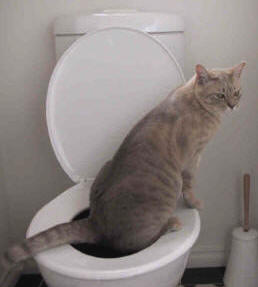Never Flush Cat Poop Down Your Toilet - Safeguard Your Plumbing Infrastructure
Never Flush Cat Poop Down Your Toilet - Safeguard Your Plumbing Infrastructure
Blog Article
The content which follows relating to Don’t flush cat feces down the toilet is especially enlightening. You should read it.

Introduction
As pet cat owners, it's necessary to bear in mind just how we get rid of our feline close friends' waste. While it might appear hassle-free to purge feline poop down the bathroom, this method can have harmful repercussions for both the environment and human health.
Ecological Impact
Flushing feline poop introduces hazardous virus and bloodsuckers right into the supply of water, positioning a substantial danger to aquatic ecological communities. These impurities can negatively affect marine life and compromise water quality.
Wellness Risks
In addition to ecological concerns, flushing pet cat waste can also present health and wellness dangers to humans. Cat feces might contain Toxoplasma gondii, a parasite that can trigger toxoplasmosis-- a possibly serious ailment, particularly for expecting ladies and people with weakened body immune systems.
Alternatives to Flushing
The good news is, there are more secure and extra accountable methods to dispose of cat poop. Consider the following options:
1. Scoop and Dispose in Trash
The most typical approach of taking care of pet cat poop is to scoop it into a naturally degradable bag and throw it in the garbage. Make certain to use a devoted trash scoop and get rid of the waste quickly.
2. Usage Biodegradable Litter
Choose naturally degradable cat clutter made from materials such as corn or wheat. These clutters are eco-friendly and can be safely taken care of in the trash.
3. Hide in the Yard
If you have a lawn, consider burying pet cat waste in an assigned area far from veggie gardens and water resources. Make certain to dig deep enough to avoid contamination of groundwater.
4. Mount a Pet Waste Disposal System
Buy a pet waste disposal system specifically created for cat waste. These systems use enzymes to break down the waste, minimizing smell and ecological influence.
Conclusion
Liable pet ownership extends past providing food and sanctuary-- it also involves proper waste administration. By refraining from flushing cat poop down the bathroom and selecting different disposal approaches, we can minimize our environmental footprint and safeguard human health.
Why Can’t I Flush Cat Poop?
It Spreads a Parasite
Cats are frequently infected with a parasite called toxoplasma gondii. The parasite causes an infection called toxoplasmosis. It is usually harmless to cats. The parasite only uses cat poop as a host for its eggs. Otherwise, the cat’s immune system usually keeps the infection at low enough levels to maintain its own health. But it does not stop the develop of eggs. These eggs are tiny and surprisingly tough. They may survive for a year before they begin to grow. But that’s the problem.
Our wastewater system is not designed to deal with toxoplasmosis eggs. Instead, most eggs will flush from your toilet into sewers and wastewater management plants. After the sewage is treated for many other harmful things in it, it is typically released into local rivers, lakes, or oceans. Here, the toxoplasmosis eggs can find new hosts, including starfish, crabs, otters, and many other wildlife. For many, this is a significant risk to their health. Toxoplasmosis can also end up infecting water sources that are important for agriculture, which means our deer, pigs, and sheep can get infected too.
Is There Risk to Humans?
There can be a risk to human life from flushing cat poop down the toilet. If you do so, the parasites from your cat’s poop can end up in shellfish, game animals, or livestock. If this meat is then served raw or undercooked, the people who eat it can get sick.
In fact, according to the CDC, 40 million people in the United States are infected with toxoplasma gondii. They get it from exposure to infected seafood, or from some kind of cat poop contamination, like drinking from a stream that is contaminated or touching anything that has come into contact with cat poop. That includes just cleaning a cat litter box.
Most people who get infected with these parasites will not develop any symptoms. However, for pregnant women or for those with compromised immune systems, the parasite can cause severe health problems.
How to Handle Cat Poop
The best way to handle cat poop is actually to clean the box more often. The eggs that the parasite sheds will not become active until one to five days after the cat poops. That means that if you clean daily, you’re much less likely to come into direct contact with infectious eggs.
That said, always dispose of cat poop in the garbage and not down the toilet. Wash your hands before and after you clean the litter box, and bring the bag of poop right outside to your garbage bins.
https://trenchlesssolutionsusa.com/why-cant-i-flush-cat-poop/

I have been very taken with Can You Flush Cat Poo or Litter Down the Toilet? and I am assuming you enjoyed the new entry. If you please take the opportunity to distribute this post if you liked it. Thanks a lot for your time. Don't forget to check our website back soon.
Go Company Report this page